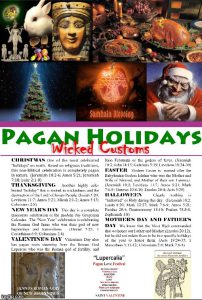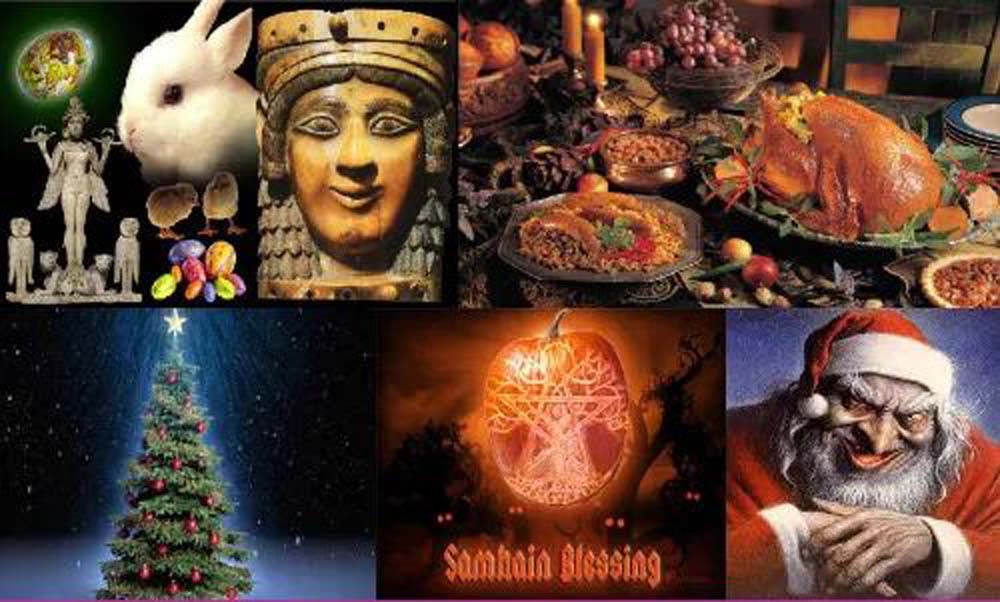
The “new year” isn’t in the dead of winter friends. How New Year Celebrations Began. The first known record of New Year’s celebrations began about 2000 B.C. in Mesopotamia. This occurred at the time of the vernal equinox, which is toward the end of March. Babylonians would have a religious festival named Akitu taken from the Sumerian term for barley. They know and are mocking you with April 1st being April Fools Day in Ameruka Inc. New life begins in spring, not in the cold frozen winter. Nothing new under the sun! It’s just repackaged for every new generation to keep them in slumber.
The origins of Christmas predate Christianity through the Pagan holiday called Saturnalia, which was a week-long of lawlessness from December 17th through December 25th that honored Saturn and included human sacrifice, intoxication, naked caroling and rape. During these seven days, there were no punishments for breaking any laws, according to Roman law.
Easter was originally the celebration of Ishtar, the Assyrian and Babylonian goddess of fertility and sex. Her symbols (like the egg and bunny) were and still are fertility and sex symbols (or did you actually think eggs and bunnies had anything to do with the resurrection?) After Constantine decided to Christianize the Empire, Easter was changed to represent Jesus. But at its roots, Easter (which is how you pronounce Ishtar) is all about celebrating fertility and sex.
Halloween, Samhain, Day Of The Dead Necromancy
Halloween has its roots in the ancient, pre-Christian Celtic festival of Samhain, which was celebrated on the night of October 31. The Celts, who lived 2,000 years ago in the area that is now Ireland, the United Kingdom and northern France, believed that the dead returned to earth on Samhain.
Samhain is a pagan religious festival originating from an ancient Celtic spiritual tradition. In modern times, Samhain (a Gaelic word pronounced “SAH-win”) is usually celebrated from October 31 to November 1 to welcome in the harvest and usher in “the dark half of the year.” Celebrants believe that the barriers between the physical world and the spirit world break down during Samhain, allowing more interaction between humans and denizens of the Otherworld.
Día de los Muertos, or Day of the Dead, celebrated on Nov. 1 and 2, draws on pre-Hispanic Mexican and Spanish Roman Catholic traditions intended to facilitate the return of departed souls to the Earth.
St. Valentine was famously executed on February 14 in the 3rd century A.D. However, according to ancient accounts, more than one St. Valentine was executed on that same day in the same century. Valentine’s Day started as a Christian celebration of this martyrdom and, fueled by romantic poets and writers, gradually morphed into a broader celebration of love. In ancient Rome, Lupercalia was celebrated on February 15 every year. It was a wild Pagan celebration of sex, violence, and fertility. The word “Lupercalia” was likely derived from “lupus,” the Latin word for “wolf.” The name of the festival was probably referencing Romulus and Remus, the founders of ancient Rome who—according to legend—were raised by a female wolf. Lupercalia is also connected with Lupercus, a Roman fertility god.
Sirius is the brightest star in the sky twenty times brighter than our present sun and is located in the constellation Canis Major. The Founding Fathers of America started to celebrate the July 4th Declaration of Independence Day in 1776 as established by Freemasons notably George Washington, Thomas Jefferson, Benjamin Franklin, and other astrologers-masons who planned and designed the national capital region area. From the ancient concept of “as above so below”, they built the structures aligned to heavenly bodies and star maps particularly the heliacal rising of star Sirius at a certain time of the year.
The Fourth of July Declaration of Independence was linked to the brightest star in the heavens, Sirius. Every year on July 4 after sunrise from our earth’s position, our present sun is in conjunction with Sirius. Esoterically this star is the Mason’s Blazing Star when conjoining with the sun and aligning with the stars in Hyades and Pleiades during a certain period of the ages caused by the precession of the equinox.
This alignment is associated with liberation, the concept of freedom, spirituality in human consciousness, and enlightenment with God because of the lights coming from this star system.
Beltane is a Pagan holiday, and one of the eight Sabbats. It falls about halfway between the spring equinox (Ostara) and the coming summer solstice, Litha. The holiday celebrates spring at its peak, and the coming summer. Beltane also sometimes goes by the name May Day.
May Day, also called Workers’ Day or International Workers’ Day, day commemorating the historic struggles and gains made by workers and the labour movement, observed in many countries on May 1. In the United States and Canada a similar observance, known as Labor Day, occurs on the first Monday of September.

